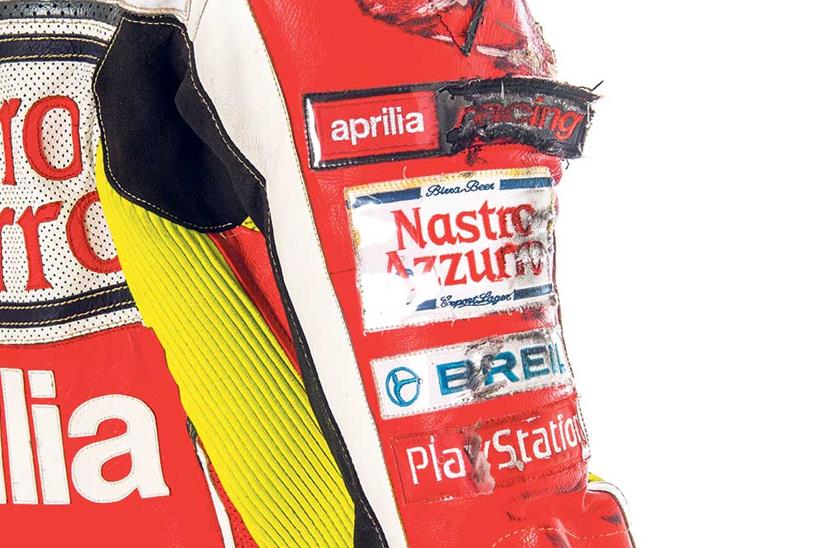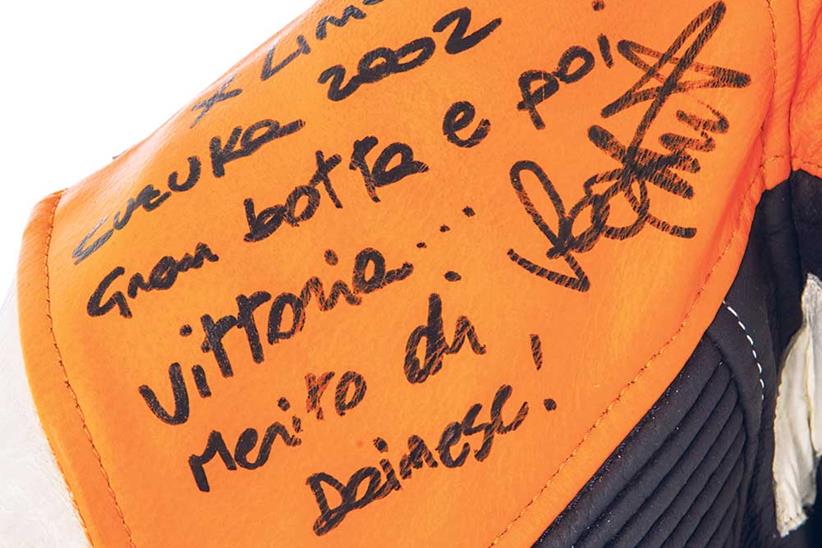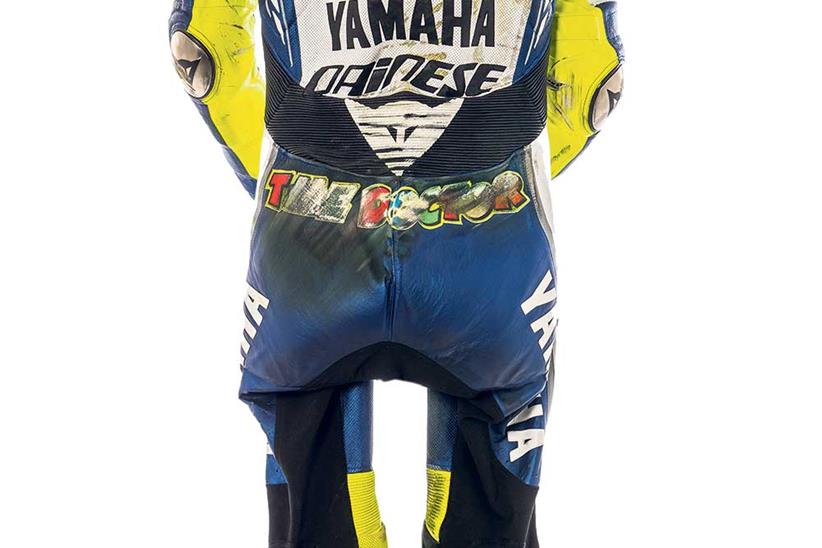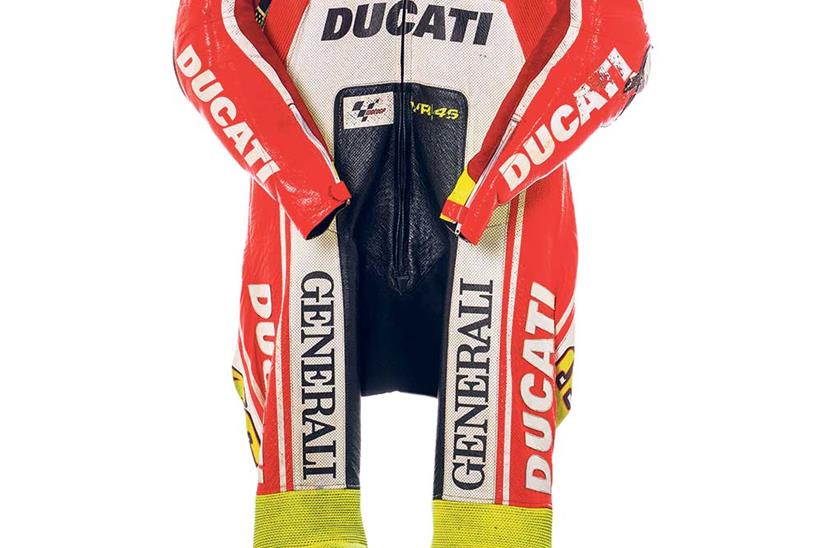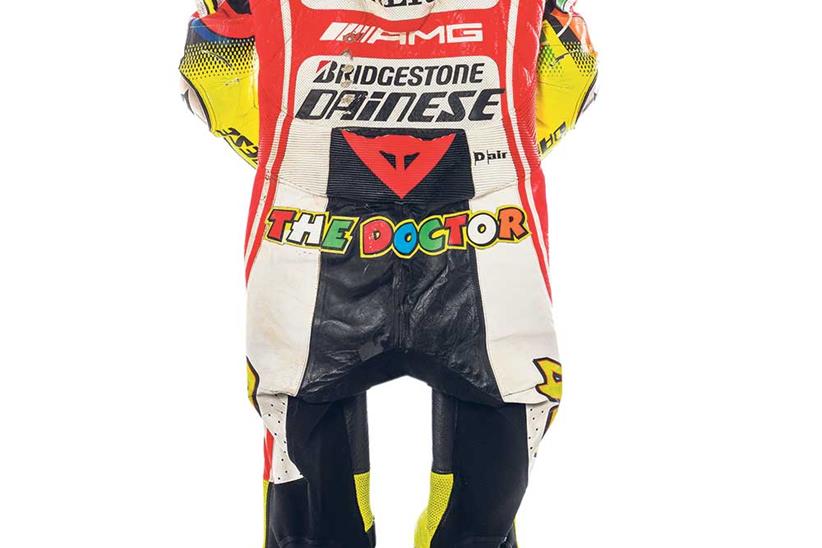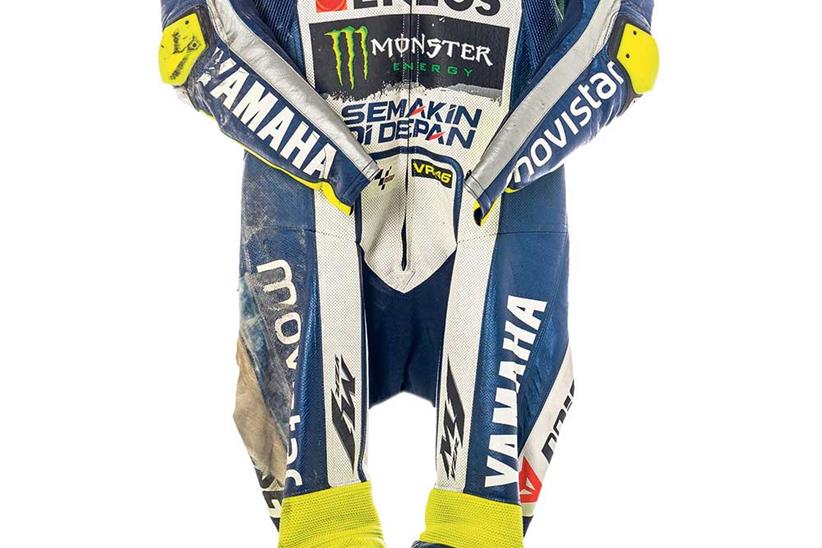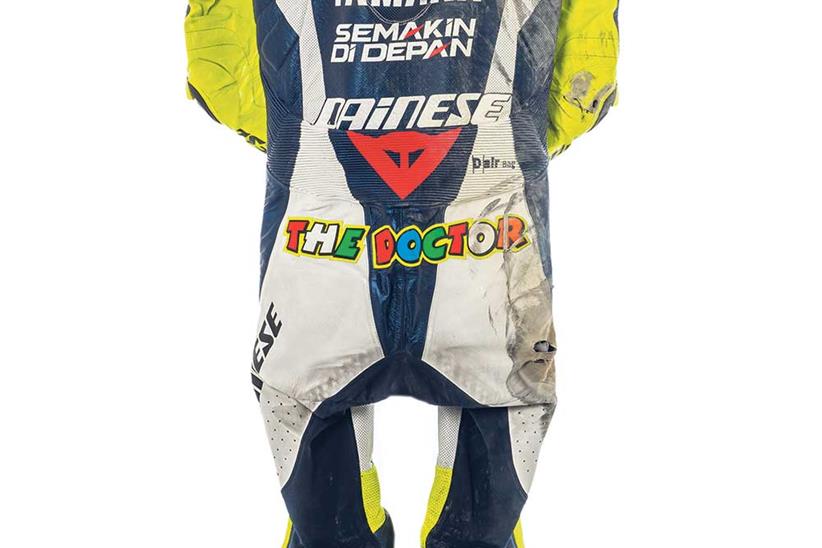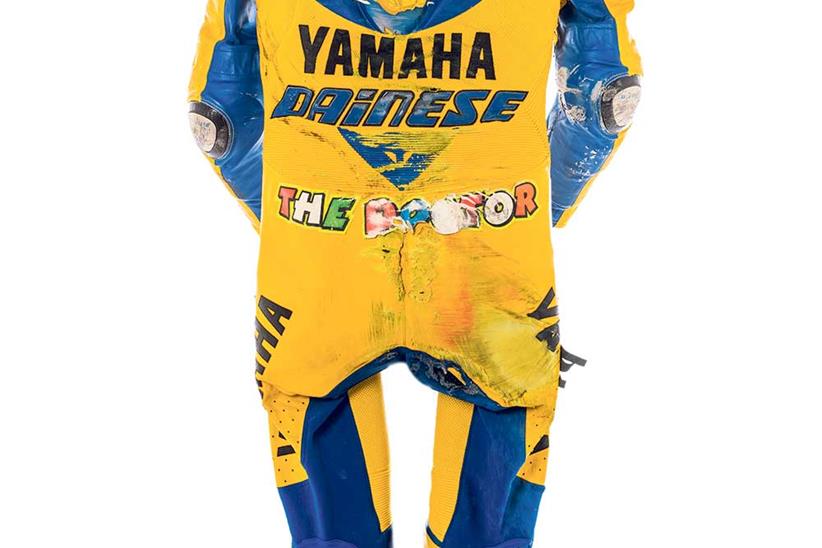Dainese's secret stash of Rossi suits revealed (part 1)
The nine times world champion has won all his titles in Dainese leathers, MCN is granted unique access to the factory’s secret stash of Rossi suits
Valentino Rossi and Dainese are celebrating a magical 20-year partnership. Rossi has been a Dainese supported rider since he started in GPs in 1996 at just 17 years of age. Incredibly just one man, Dainese master tailor Silvano Celi, has been responsible for every set of leathers Rossi has worn. For two decades the pair have created some of the most memorable and champagne-soaked suits in racing history. We spent the day with Silvano, a close friend of Rossi, in the Dainese vault in Molvena, Italy to discover the secrets of the greatest racer’s leathers.
The entrance to the Dainese vault isn’t impressive. It’s just a plain white door in a building full of busy seamstresses and designers working on the new range of factory race leathers for the 2016 season. Yet behind the door are over a thousand suits spanning 40 years of crashing, winning and everything in between.
As soon as the door opens I’m engulfed by the smell of race leathers; a lovely fragrance to any biker, right up there with the aroma of two-stroke. The Aladdin’s Cave of leathers is like a private museum, very rarely seen by anyone outside of Dainese.
My eyes are wide, struggling to take in the sheer scale of handcrafted racing history that’s being carefully hung from the roof. From Sheene to Rossi, it’s all here.
A proud Silvano Celi welcomes me with open arms and I’m immediately drawn to the older leathers from the 1990s. I spot a Troy Bayliss suit, then a Pierfrancesco Chili suit, the odd Carl Fogarty, an Anthony Gobert, Scott Russell… they all hang here perfectly preserved in time. Behind them I see an Eddie Lawson suit from the golden era of 500 Grand Prix. Further along are more GP leathers – Loris Capirossi and Max Biaggi from their 250 days – mixed in with some modern leathers that once belonged to Leon Haslam.
Name a rider and a year and Silvano will know precisely where the leathers are. Most are used and worn, some heavily crashed in. Foggy’s leathers from the Phillip Island crash that ended his career in 2000 are here, so are Valentino Rossi’s Mugello leathers, the ones that had to be cut away after he broke his leg. Not only this, but here there are boots, gloves and body armour from a plethora of legendary riders.
Silvano leads me to one particular rack. On it are 20 sets of leathers, one for each year of Rossi’s GP career. They tell the story of perhaps the greatest racer of all time, and also chart the technological developments of Dainese’s one-piece race suits. “So,” says Silvano, “what would you like to know?”
Who is Silvano Celi?
Silvano Celi, 49, is the master tailor at Dainese, where he has worked for 30 years. Silvano first started working closely with riders like Loris Reggiani, Fausto Gresini, and 250 champ Luca Cadalora. Silvano has known Rossi since he was 14 years old and has made every set of leathers Vale has ever worn. That’s every set of leathers for the last 20 years, from winter testing to special one-off designs.
1999 Aprilia. 1st 250GP championship, 9 wins
![]()
The Nastro Azzurro Aprilia leathers featured the famous moon and sun logo for the first time, and depict the two opposite sides of life. Rossi’s master tailor Silvano Celi says this has nothing to do with Rossi’s personality as “Valentino is always happy”. The WLF logo appears on the lapel on the neck and translates, rudely and roughly, into ‘long live pussy’.
The cause of the crash damage on this suit is unknown. Rossi used eight suits this year, four sets more than usual because Silvano was being experimental. Rossi was always willing to try new ideas, wanting to know what was around the corner, technology- wise. According to Silvano, even when Vale was 14 he would be at the Dainese truck trying to get hold of the latest kit.
The GP season was also getting longer with more rounds, therefore Rossi needed more leathers and was still growing. “Valentino didn’t grow a huge amount more after this, in fact he weighs much the same as he did back then.”
2002 Honda, 1st MotoGP, 11 wins
![]() First year on the new four-stroke RC213V and Rossi’s first year in Repsol colours. The sun and the moon have changed their faces a little and the WLF logo is in the colours of the Italian flag. Silvano says the leathers had to be changed a little with the arms closer to the body and the forearms made slightly wider to compensate for muscle pump, a by-product of the move to the more physical four-stroke machines. In testing Rossi preferred the older 500 two-stroke, but despite 500s still being eligible Honda wouldn’t let him start the season on the old bike.
First year on the new four-stroke RC213V and Rossi’s first year in Repsol colours. The sun and the moon have changed their faces a little and the WLF logo is in the colours of the Italian flag. Silvano says the leathers had to be changed a little with the arms closer to the body and the forearms made slightly wider to compensate for muscle pump, a by-product of the move to the more physical four-stroke machines. In testing Rossi preferred the older 500 two-stroke, but despite 500s still being eligible Honda wouldn’t let him start the season on the old bike.
The crash damage is from a high speed off in practice for the Japanese GP. Rossi escaped uninjured and was so impressed with the protection he signed the leathers with a thank you note. Rossi went on to win the race and recollects it wouldn’t have been possible without his Dainese leathers, which saved him in practice.
2006 Yamaha. 2nd MotoGP, 5 wins
![]() Rossi, now backed by Camel, was leading the championship going into the final round in Valencia but crashed, handing the title to Nicky Hayden.
Rossi, now backed by Camel, was leading the championship going into the final round in Valencia but crashed, handing the title to Nicky Hayden.
Rossi’s Camel leathers are now fully vented front and rear, a first in 2006 as previously they’d only been vented in the front. Dainese had to improve the suit’s internal structure to maintain the suit’s strength, but Rossi much preferred the fully vented leathers, particularly at hot and humid races like Malaysia. The damage is from a huge crash at Assen, which was one of the biggest of Rossi’s career. According to the datalogger it was a 120mph highside, with Rossi officially suffering heavy bruising and micro fractures to the ankle and scaphoid, though Silvano also remembers two fractured ribs and a huge hit to Rossi’s right elbow, too. Rossi went on to race and finished eighth.
At the next round at Donington Park, Silvano showed Rossi his back protector from the Assen crash. “You could see the outline of his spine,” says Silvano. “There was a perfect imprint on the inside of the back protector.” As soon as Rossi realised the enormity of the crash he kissed the back protector before racing in the British GP.
2007 Yamaha. 3rd MotoGP, 4 wins
![]() MotoGP moved into a new era with 800cc machines, and Casey Stoner took his first world championship on the very fast Ducati GP7 that dominated the year. This crash damage is from another highside, this time at Valencia’s turn one. Data showed Rossi was doing 100mph when he was thrown over the bars in free practice. It was reported that Rossi had broken his right hand and it looked like he was going to miss the race, the first since his debut a staggering 191 races before.
MotoGP moved into a new era with 800cc machines, and Casey Stoner took his first world championship on the very fast Ducati GP7 that dominated the year. This crash damage is from another highside, this time at Valencia’s turn one. Data showed Rossi was doing 100mph when he was thrown over the bars in free practice. It was reported that Rossi had broken his right hand and it looked like he was going to miss the race, the first since his debut a staggering 191 races before.
But Rossi did go on to race. Silvano had to heavily modify the glove, linking two fingers together to ease the pain. You can see the wear on the front of the leathers from the chest protector as Rossi slid down the track and over the kerb face first. Rossi only started to wear a chest protector after his 2006 Assen crash (see opposite page).
The fur on the back of the leathers was specially made by Silvano for Rossi. According to Silvano, Rossi was at a Dainese winter show for their new ski wear range, where he spotted some furry boots and asked if he could have the same. Silvano obliged and made Rossi a pair of furry race boots for winter testing. Rossi loved the full fur race boots, and then opted to add some fur to his leathers.
2011 Ducati. 7th in MotoGP, no wins
![]() Rossi joined Ducati and old team-mate Nicky Hayden at Ducati but only made the podium once. Silvano was as busy as ever as Rossi struggled with the Desmosedici GP11. Rossi crashed 12 times, which was more than ever before in his MotoGP career, but the D-Air airbag system was activated for only 50% of them. Lowsides and less aggressive spills didn’t trigger the airbag, and many of Rossi’s Ducati crashes were caused when he lost the front end, sliding off into the gravel. Silvano had to produce 18 different sets of leathers as superstitious Rossi always wears new leathers after a crash. Silvano also increased the Kevlar protection on the shin to protect Rossi’s weakened lower leg following his bone-crunching Mugello crash in the previous season.
Rossi joined Ducati and old team-mate Nicky Hayden at Ducati but only made the podium once. Silvano was as busy as ever as Rossi struggled with the Desmosedici GP11. Rossi crashed 12 times, which was more than ever before in his MotoGP career, but the D-Air airbag system was activated for only 50% of them. Lowsides and less aggressive spills didn’t trigger the airbag, and many of Rossi’s Ducati crashes were caused when he lost the front end, sliding off into the gravel. Silvano had to produce 18 different sets of leathers as superstitious Rossi always wears new leathers after a crash. Silvano also increased the Kevlar protection on the shin to protect Rossi’s weakened lower leg following his bone-crunching Mugello crash in the previous season.
2015 Yamaha. 2nd in MotoGP, 4 wins
![]() These are Rossi’s current leathers and feature permanent elbow sliders for the first time (Stefan Bradl was the first Dainese rider to have permanent elbow sliders fitted to a suit). The crash damage is from a Michelin test at Mugello’s Arrabbiata One at 88mph. It was a simple lowside and the airbag was deployed. Each airbag deployment is recorded by Dainese and made public via their Facebook page. They have had over 500 airbag deployments in MotoGP since they introduced the D-Air leathers and only one collarbone injury.
These are Rossi’s current leathers and feature permanent elbow sliders for the first time (Stefan Bradl was the first Dainese rider to have permanent elbow sliders fitted to a suit). The crash damage is from a Michelin test at Mugello’s Arrabbiata One at 88mph. It was a simple lowside and the airbag was deployed. Each airbag deployment is recorded by Dainese and made public via their Facebook page. They have had over 500 airbag deployments in MotoGP since they introduced the D-Air leathers and only one collarbone injury.





